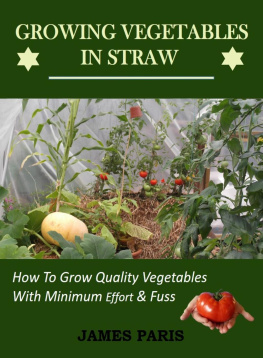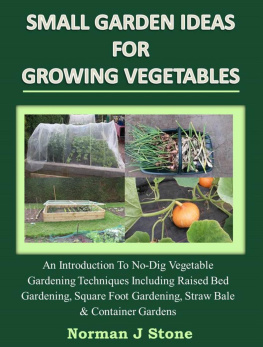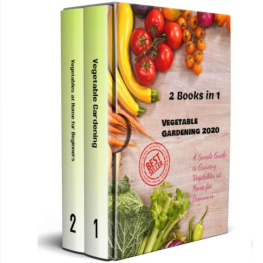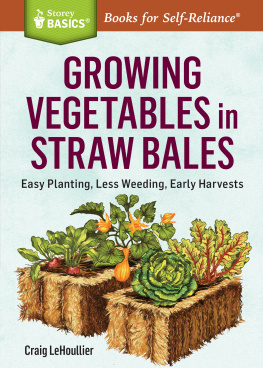STRAW BALE
GARDENS
The Breakthrough Method for
Growing Vegetables Anywhere,
Earlier and with No Weeding

JOEL KARSTEN



Grandma Josephines garden
If we had ever printed business cards for my Grandma Josephine, her position would have been listed as professional gardener because it was the one thing she knew more about than pretty much anyone else in the county. When she heard that my plan after high school was to attend the University of Minnesota and major in horticulture, she was heard to say, I could teach that boy everything hell ever need to know about growing a garden, and he wont need to leave the farm or pay any tuition at all. She was, in fact, one of the best professors of horticulture that I would ever have. She started planting her own garden when she was around 16 and she gardened right up to the end of her life at 93. She worked her garden until she couldnt get down on the ground anymore. As she put it, Getting down is easy, its getting up where the problem lies. There came a time when she relied on her son, my dad, to do the heavy work and eventually I took over as her day-to-day helper.
She loved the idea of gardening as much as she loved the garden itself. She spent her winters dreaming and planning ahead for springreading every seed catalog that arrived from cover to cover and getting her orders together. She gardened her own way, not always following conventions. Who knows, perhaps she was the true inspiration of the Straw Bale Gardening technique. She inspired me to try something different, based on a hunch, that nobody thought at the time would actually work. Although she was gone by the time the Straw Bale Garden was born, I often wonder what she would have to say about all the people stopping by the farm at all hours, all summer long, just to get a peek at the garden and to see how Straw Bale Gardening is done. I dont know if it would have upset her or made her really happy. My only regret is that I didnt get to show her how easy it is to garden my way. She would have loved that. Work smarter, not harder was something she believed, and her gardens were proof. Overlook the weeds, and just focus on the flowers was another saying of hers, which works well for a gardener and isnt bad advice other aspects of life, as well.
First published in 2013 by Cool Springs Press, an imprint of the Quayside Publishing Group, 400 First Avenue North, Suite 300, Minneapolis, MN 55401
2013 Cool Springs Press Text 2013 Joel Karsten
All rights reserved. With the exception of quoting brief passages for the purposes of review, no part of this publication may be reproduced without prior written permission from the Publisher.
The information in this book is true and complete to the best of our knowledge. All recommendations are made without any guarantee on the part of the author or Publisher, who also disclaims any liability incurred in connection with the use of this data or specific details.
Cool Springs Press titles are also available at discounts in bulk quantity for industrial or sales-promotional use. For details write to Special Sales Manager at Cool Springs Press, 400 North First Avenue, Suite 300, Minneapolis, MN 55401 USA. To find out more about our books, visit us online at www.coolspringspress.com.
Digital Edition: 978-1-61058-738-9
Hardcover Edition: 978-1-59186-550-6
Library of Congress Cataloging-in-Publication Data
Karsten, Joel, 1969
Straw bale gardens : the breakthrough method for growing vegetables anywhere earlier and with no weeding /Joel Karsten.
p. cm.
Breakthrough method for growing vegetables anywhere earlier and with no weeding
Includes index.
ISBN 978-1-59186-550-6 (softcover)
1. Vegetable gardening. 2. Container gardening. 3. Raised bed gardening. 4. Compost. I. Title. II. Title: Breakthrough method for growing vegetables anywhere earlier and with no weeding.
SB324.4.K37 2013
635--dc23
2012042826
Editor: Mark Johanson
Design Manager: Cindy Samargia Laun
Design: Pauline Molinari
Cover Design: Karl Laun
Photography: Tracy Walsh
Illustration: Pam Powell
10 9 8 7 6 5 4 3 2 1
Additional photo credits:
Contech Enterprises:
iStock: (left)
Paul Markert:
Philadelphia Inquirer:
Shutterstock:
Lynn Steiner:


Because the straw bale generates heat as the straw decomposes, a Straw Bale Garden can get a head start in planting and yield ripe tomatoes weeks before the other gardens in town.
STRAW BALE GARDENING might seem like a strange idea at first. When people hear about it for the first time, they almost always ask the same question: Does the plant actually grow in the bale? It seems that were so accustomed to the idea that plants only grow in soil that we have a hard time getting our heads around the idea of dirtless gardening. But the answer is yes. You plant your garden directly in bales of straw. Add some water, fertilizer and sunshine (not necessarily in that order) and your garden will explode with beautiful, wholesome produce. No tilling, no cultivating, no weeding. It really works. And it is growing. When you count up all the people who have attended my straw bale seminars, Liked my Straw Bale Facebook page and bought my booklet on Straw Bale Gardens from my website, you get a number thats nearing a hundred thousand. And those are just the Straw Bale Gardeners I know about.
If you pay much attention to gardening, you know that two of the most popular kinds of gardening today are vegetable gardening (as with the whole Urban Homestead trend) and container gardening. Straw bale gardening combines these two by growing vegetables (yes, you can grow flowers too) in what is arguably natures perfect container: the straw bale. Straw bales arent just the container, you see, they are also the growing media. As the straw inside the bale decomposes it provides nutrients for the plant for the whole growing season. Then, in the Fall, you toss whatever is left of the bale onto your compost heap and you start with a fresh bale in the Spring. The straw bale cycle is complete, and your root cellar is full of fabulous home-grown food.
A little bit of history
Straw Bale Gardens came about sort of by accident. As any kid who grew up on a farm like me can tell you, straw bales are everywhereespecially if you raise livestock. Straw is used mostly for animal bedding (see the next chapter Straw). Its a valuable commodity and it consumes a lot of a farmboys summer. Stacking straw bales on a bale rack, then stacking bales, and then stacking more bales was a job that never seemed to end. It starts from the moment a farm kid is big enough to lift a bale of straw and smart enough to stack the rack securely to avoid a rack disaster. In fact, one coming-of-age moment in farm life happens the first time you are trusted to stack bales on a rack by yourself. If your rack makes it to the barn without spilling any bales, you are one step closer to becoming a farm man.













